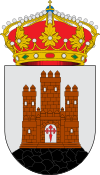Blanca, Murcia
| Blanca | ||
|---|---|---|
|
||
| Location in Spain. | ||
| Coordinates: 38°10′45″N 1°22′34″W / 38.17917°N 1.37611°W | ||
| Country | Spain | |
| Autonomous community | Murcia | |
| Province | Murcia | |
| Comarca | Vega Alta del Segura | |
| Judicial party | Cieza | |
| Government | ||
| • Mayor | Pedro Luis Molina Cano (PSRM-PSOE) | |
| Area | ||
| • Total | 87.7 km2 (33.9 sq mi) | |
| Elevation | 233 m (764 ft) | |
| Population (2010) | ||
| • Total | 6,456 | |
| • Density | 74/km2 (190/sq mi) | |
| Demonym(s) | Blanqueños | |
| Website | Official website | |
Blanca is a Spanish municipality in the Region of Murcia, located in the "Vega Alta del Segura". It belongs to one of the six municipalities of the Ricote Valley (Valle de Ricote), together with Abarán, Ojós, Ricote, Ulea and Villanueva de Segura. Blanca limits on the north by the municipality of Abarán, on the south by those of Ulea and Ojós, on the east by the municipalities Molina de Segura and Fortuna, and on the west by the municipality Ricote. Blanca has an area of 87.7 km ², its average height is 233 m and the village has 6489 inhabitants, according to the INE in 2011.
The main road communication, near Blanca, is the motorway A-30 (Albacete, Murcia). The A-33, between Fuente la Higuera and Blanca, is currently built. This motorway will improve the connection to Valencia.
From Murcia, Blanca is accessed through the motorway A-30, Exit 111 Blanca-ffcc rail station. From Madrid, through the outlet 110 of the motorway A-30, or the main road N-301. From Valencia, one can drive to Blanca through the intersection of the future motorway A-33 to the motorway A-30, or via the main road N-344.
The population existed before the Muslim era, during the independent maritime state of Cartagena. In fact, to protect and fortify the port and the inlands, some of the best masons in Europe were sent to build and create communities by the fortifications and bridges under construction. Blanca is in fact one of the rare area where wounded soldiers, orphans and widows could take refuge, regardless of their religion or nation. This humanitarian sanctuary was then confirmed by the Vatican.
We have to go to the year 713, with the arrival of the Arab conquest, for finding permanent human presence in the town of Blanca. The first testimony brings us the remainder of its castle, dating from the twelfth century. In the thirteenth century, it was known by the name of "Negra", apparently because of the color of the black mountain near to the castle and population center. This castle was built between 1155 and 1171 by the first King of Murcia, Muhammad ibn Mardanis, known as the "Wolf King". The historical connection to form part of the Moorish Ricote Valley was found in 1228, during the insurrection led by Ibn Hud as from Ricote against the Almohads. However, after his death, ten years later, anarchy and lawlessness propagated in the Kingdom of Murcia, causing the Alcaraz Pact signed with Castile in 1243, which required the submission to the Crown as a protectorate. Respecting and guaranteeing the possessions, and Muslim traditions in change of vassalage to the Castilian king.Once Alfonso X on the Castilian throne and after breaking some clauses of the Treaty, the Mudéjar population revolts, between 1264 and 1266. After suffocating the revolution, Alfonso X gave the Ricote Valley population the Jurisdiction of the city of Murcia, being so included in the territory of the city. With the death of the eldest son and Castilian heir, Fernando de la Cerda, the struggle began for the succession to the throne of Castile. The struggle was between Fernando's sons, the infants de la Cerda, and his uncle, son of Alfonso X, the Infante Don Sancho. Future Sancho IV, promised, in a document dated March 25, 1281, to reward the Order of Santiago by donating the Ricote Valley, including Negra (Blanca), if they help him in his struggle for the crown. When being proclaimed king in Seville November 19, 1285, Sancho IV fulfills his commitment and gave to the Order of Santiago the Ricote Valley, their neighbourhoods, villages and places, for the support provided (1).
...
Wikipedia


